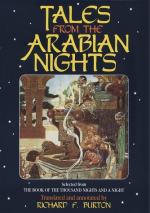[FN#315] Light of the Day.
[FN#316] Galland has “Bisnagar,” which the H. V. corrupts to Bishan-Garh = Vishnu’s Fort, an utter misnomer. Bisnagar, like Bijnagar, Beejanuggur, Vizianuggur, etc., is a Prakrit corruption of the Sanskrit Vijayanagara = City of Victory, the far-famed Hindu city and capital of the Narasingha or Lord of Southern India, mentioned in The Nights, vols. vi. 18; ix. 84. Nicolo de’ Conti in the xvth century found it a magnificent seat of Empire some fifteen marches south of the pestilential mountains which contained the diamond mines. Accounts of its renown and condition in the last generation have been given by James Grant ("Remarks on the Dekkan”) and by Captain Moore ("Operations of Little’s Detachment against Tippoo Sultan"). The latest description of it is in “The Indian Empire,” by Sir William W. Hunter. Vijayanagar, village in Bellary district, Madras, lat. 15 degrees 18’ N., long. 76 degrees 30’ E., pop. (1871), 437, inhabiting 172 houses. The proper name of this village is Hampi, but Vijayanagar was the name of the dynasty (?) and of the kingdom which had its capital here and was the last great Hindu power of the South. Founded by two adventurers in the middle of the xivth century, it lasted for two centuries till its star went down at Talikot in A. D. 1565. For a description of the ruins of the old city of Vijayanagar, which covers a total area of nine square miles, see “Murray’s Handbook for Madras,” by E. B. Eastwick (1879), vol. ix. p. 235. Authentic history in Southern India begins with the Hindu kingdom of Vijayanagar, or Narsinha, from A. D. 1118 to 1565. The capital can still be traced within the Madras district of Bellary, on the right bank of the Tungabhadra river—vast ruins of temples, fortifications, tanks and bridges, haunted by hyaenas and snakes. For at least three centuries Vijayanagar ruled over the southern part of the Indian triangle. Its Rajas waged war and made peace on equal terms with the Mohamadan sultans of the Deccan. See vol. iv. p. 335, Sir W. W. Hunter’s “Imperial Gazetteer of India,” Edit. 1881.




